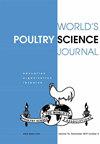Use of Galleria mellonella as a Model for Insect Vector Transmission of the Foodborne Pathogen Campylobacter jejuni in Broiler Chickens: A Pilot Study
IF 3.5
3区 农林科学
Q1 AGRICULTURE, DAIRY & ANIMAL SCIENCE
引用次数: 0
Abstract
There is growing pressure to find a way to eradicate or reduce the levels of foodborne pathogens such as Campylobacter in broiler chickens, whilst limiting the use of antimicrobials. For Campylobacter, there is currently no vaccine and on-farm biosecurity alone is insufficient to prevent colonization of broiler chicken flocks. Dipteran flies are proven carriers of Campylobacter and their entry into broiler houses may contribute to its transmission to broiler chickens. As there is currently no experimental vector transmission model for Campylobacter and chickens, we decided to examine experimentally whether Galleria mellonella could be used as vector to transmit Campylobacter to broiler chickens. More recently, the use of live insect feed has been proposed both for its nutritional qualities and improving bird welfare through the encouragement of natural foraging behaviours and it is unclear any risk this poses in terms of pathogen transmission. In this study, day-old chicks (n = 29) were obtained from a commercial hatchery. At three weeks of age, birds were split into 4 This groups; Group 1 was infected via oral gavage with 106 cells of C. jejuni-M1, Group 2 was fed Galleria mellonella infected with 106 cells of C. jejuni-M1, Group 3 was fed uninfected Galleria mellonella, whilst the remaining group was unchallenged. Cloacal swabs were taken at 2, 4, and 6 days post-infection (dpi) to follow transmission and at 8 dpi birds culled and C. jejuni load quantified in the caeca and liver. At 8 dpi, all birds in both the Campylobacter gavage group and those in the group fed the Campylobacter infected Galleria mellonella were Campylobacter positive, whereas those fed uninfected Galleria mellonella and the control group were all Campylobacter negative. The mean caecal Campylobacter load in the Campylobacter gavage group was 1.7 × 1010 per gram compared with 8.6 × 109 in the group fed the Campylobacter-infected Galleria mellonella. No liver positives were found in any of the groups. Our findings indicate that feeding broiler chickens with the vector Galleria mellonella infected with C. jejuni-M1 is sufficient to establish colonisation with C. jejuni. We propose that Galleria can be used as an easy and flexible model for vector transmission of foodborne pathogens in chicken.肉仔鸡食源性病原菌空肠弯曲杆菌昆虫传播模型的初步研究
人们面临着越来越大的压力,需要找到一种方法来根除或降低肉鸡中弯曲杆菌等食源性病原体的水平,同时限制抗菌剂的使用。对于弯曲杆菌,目前没有疫苗,仅靠农场生物安全不足以防止肉鸡群的定植。双翅类蝇被证实是弯曲杆菌的携带者,它们进入肉鸡舍可能导致弯曲杆菌传播给肉鸡。由于目前还没有弯曲杆菌与鸡的实验媒介传播模型,我们决定通过实验研究是否可以利用mellongalleria作为媒介传播弯曲杆菌给肉鸡。最近,由于其营养质量和通过鼓励自然觅食行为改善鸟类福利,人们提出使用活昆虫饲料,但目前尚不清楚这在病原体传播方面是否存在风险。在本研究中,雏鸡(n = 29)从一家商业孵化场获得。在三周大的时候,这些鸟被分成4组;第1组灌胃106个空肠梭菌- m1细胞感染,第2组灌胃106个空肠梭菌- m1细胞感染的mellonia,第3组灌胃未感染的mellonia,其余组不攻毒。在感染后第2、4和6天采集肛肠拭子以追踪传播情况,并在感染后第8天扑杀禽类,并对盲肠和肝脏中的空肠梭菌量进行量化。8 dpi时,喂养弯曲杆菌组和喂养感染弯曲杆菌的mellongalleria组的鸟均呈弯曲杆菌阳性,而饲喂未感染的mellongalleria和对照组的鸟均呈弯曲杆菌阴性。弯曲杆菌灌胃组盲肠弯曲杆菌平均载量为1.7 × 1010 / g,而弯曲杆菌感染的mellongalleria灌胃组为8.6 × 109 / g。在任何一组中都没有发现肝脏阳性。我们的研究结果表明,用感染了空肠梭菌- m1的mellonia媒介喂养肉鸡,足以建立空肠梭菌的定殖。我们认为,Galleria可作为一种简便、灵活的鸡食源性病原体媒介传播模型。
本文章由计算机程序翻译,如有差异,请以英文原文为准。
求助全文
约1分钟内获得全文
求助全文
来源期刊

World's Poultry Science Journal
农林科学-奶制品与动物科学
CiteScore
6.10
自引率
7.40%
发文量
55
审稿时长
12-24 weeks
期刊介绍:
World''s Poultry Science Journal is the official publication of the World’s Poultry Science Association. The journal provides authoritative reviews in poultry science and an international forum for the exchange and dissemination of information including research, education and industry organisation. Each issue includes poultry industry-related news, regional reports on global developments in poultry, reports from specialist scientific working groups, book reviews, association news and a calendar of forthcoming events. Coverage includes breeding, nutrition, welfare, husbandry, production systems, processing, product development, physiology, egg and meat quality, industry structure, economics and education. The journal is of interest to academics, researchers, students, extension workers and commercial poultry producers.
 求助内容:
求助内容: 应助结果提醒方式:
应助结果提醒方式:


